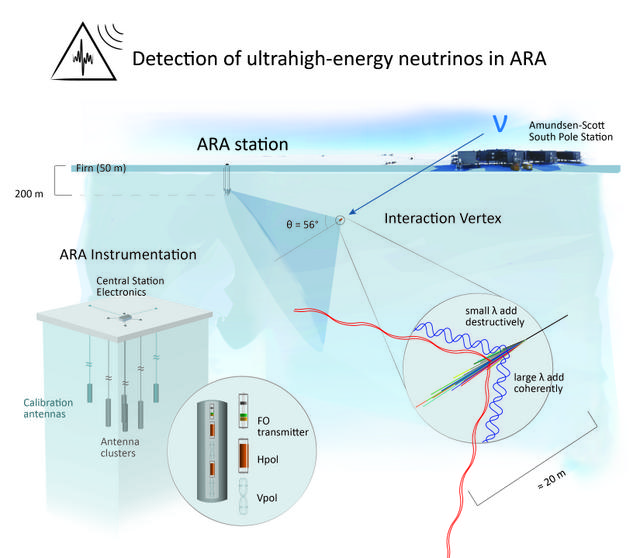The Askaryan Radio Array (ARA) is designed as a teraton-scale ultra-high-energy (UHE) neutrino detector in deep, radio-transparent ice near the Amundsen-Scott station at the South Pole. ARA aims to deploy 37 stations of antennas at 200 m depth spanning 100 km3 of ice in order to observe UHE neutrinos, with energies above 1017 eV, for the first time. These energies are more than one hundred times those of the highest energy neutrinos observed to date.
So far, one prototype ARA testbed and three full stations have been deployed. Researchers continue learning from them, while a proposal to deploy seven more stations, is waiting for a funding decision by the National Science Foundation (NSF). In the latest schedule, ARA scientists are envisioning to deploy several more stations in the 2016/17 austral summer.
The ARA Collaboration has recently published in the Astroparticle Physics journal a first search for ultra-high-energy (UHE) neutrinos performed with the ARA testbed detector. No neutrino candidate events were found, an expected result since the sensitivity of one set of antennas is insufficient to measure UHE neutrinos, but new constraints on the neutrino flux were derived.
Initial commissioning of the testbed station demonstrated detection of radio signals emitted from a 2.5 km deep impulse generator located at a distance of over 3 km. This confirmed radio attenuation lengths well over 1 km at shallow depths.

UHE neutrinos are expected to be produced directly from astrophysical sources and as decay products of the interactions of UHE cosmic rays with the cosmic microwave and infrared background radiation. Even though predicted by physicists half a century ago, they still remain undetected.
When a UHE neutrino interacts with the Antarctic ice, it produces a shower of particles that emit linearly polarized radio impulses. This effect, also called the Askaryan effect, is the result of showers of charged particles traveling through the ice at speeds faster than the velocity of light in this medium. These neutrino-induced secondary particles produce a temporary charge anisotropy that emits a cone of coherent radiation in the radio spectrum.
In its full array design, ARA will deploy a set of radio antennas, or ARA stations, every 2 km covering a total area of more than 100 km2. The design is optimized so that every neutrino interaction occurring in a volume of up to 300 cubic kilometers will be observed by one of the stations. The huge detection volume combined with continuous observation time and relatively large sky coverage makes ARA a factor of 5 to 10 times more sensitive at ultrahigh energies (1018 eV) than IceCube. This can be obtained at a relatively moderate cost estimated to be $8M total, and the technology is scalable.
Now that the detection mechanism has been proved to work, the ARA Collaboration has started to develop the analysis method and techniques. Askaryan detectors at this scale have never been built before, and while the team is aiming for the full deployment there is still a lot of work to do to fully understand the research capabilities of such detectors.
This was an important step in developing analysis techniques for ARA. “We carried out three complementary analyses within the collaboration and found similar results,” explains Amy Connolly, a assistant professor of physics at Ohio State University and the corresponding author of this paper. “This demonstrates that we understand the detector and its environment well, and as more stations are deployed, we will be sensitive to the rare ultra-high-energy neutrino fluxes that we aim to measure,” adds Connolly.
The results published today by ARA researchers have set up a benchmark for the sensitivity of ARA-37, which shows that dozens of UHE neutrinos can be detected if our models of the extreme universe are correct. This sensitivity will still increase with further improvements of the analysis and will allow the ARA Collaboration to exploit the physics and astrophysics information that neutrinos carry. “ARA is a scalable and cost effective detector that can succeed in the quest for cosmogenic neutrinos as a means of tackling the question of the origin and nature of the highest energy cosmic rays,” say Albrecht Karle, ARA principal investigator and a member of the faculty team at WIPAC.
+ Info “First Constraints on the Ultra-High Energy Neutrino Flux from a Prototype Station of the Askaryan Radio Array,” ARA Collaboration: P. Allison et al., Astropart. Phys. 70 (2015) 62-80 (2015-10), DOI: 10.1016/j.astropartphys.2015.04.006, e-Print: arXiv:1404.5285
